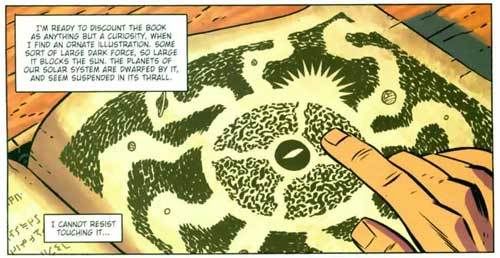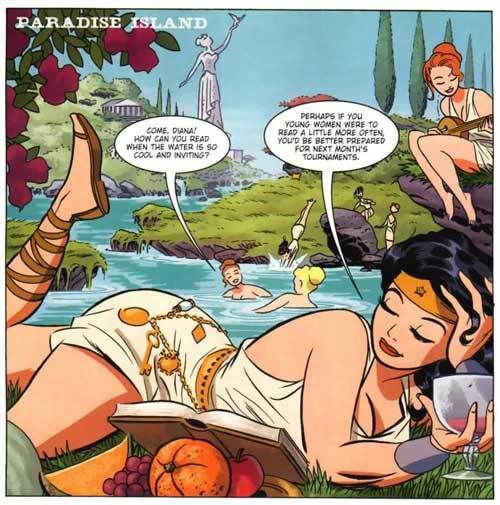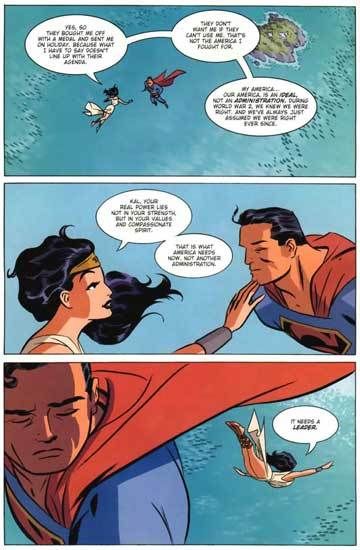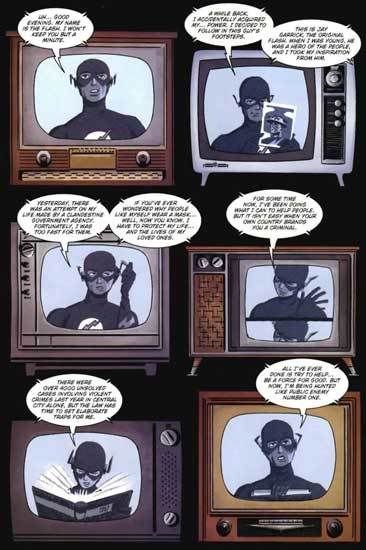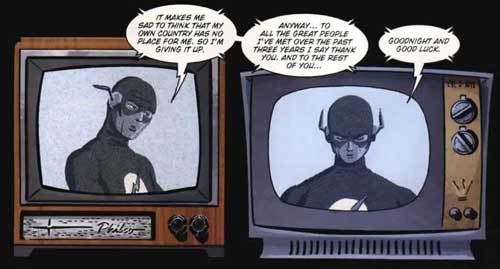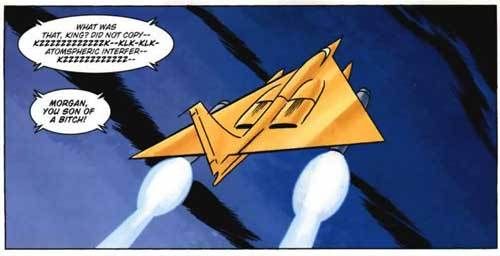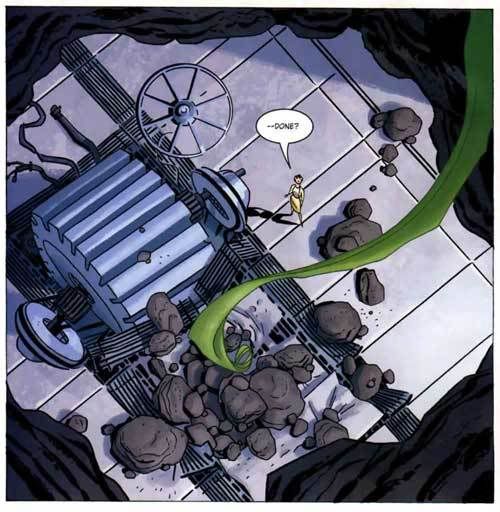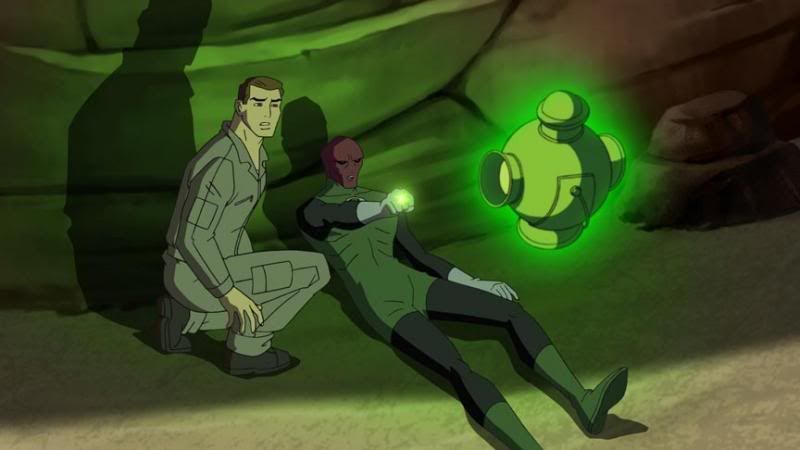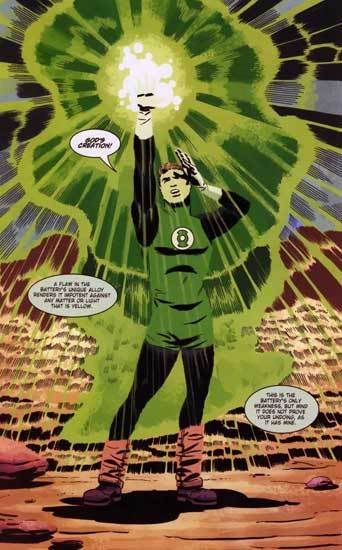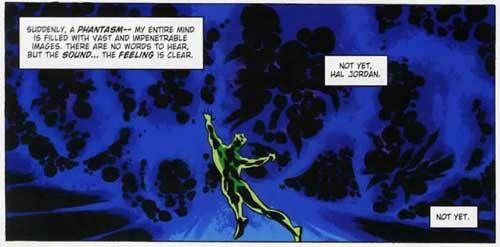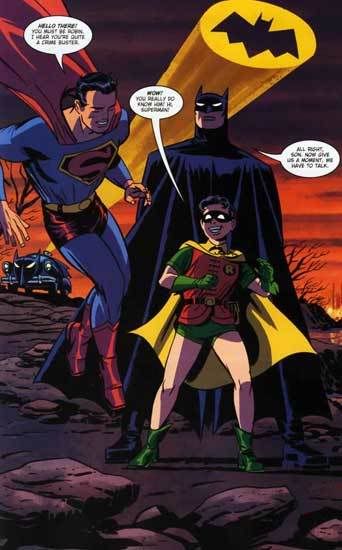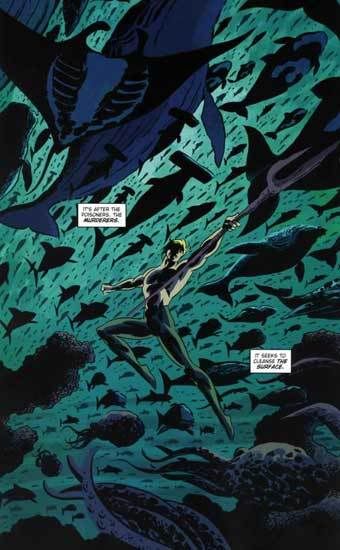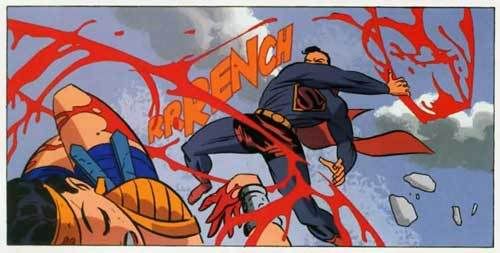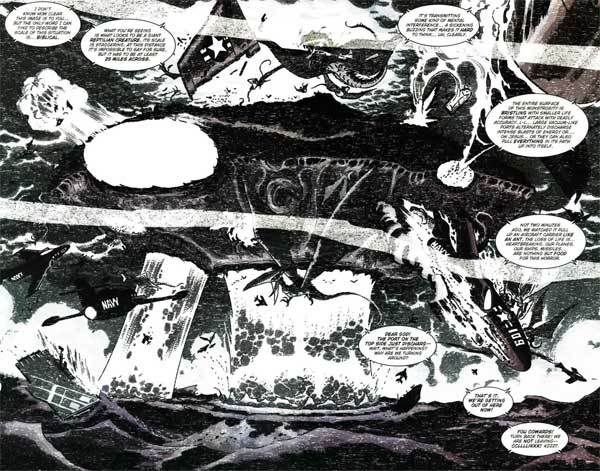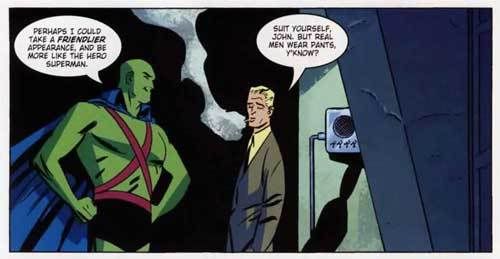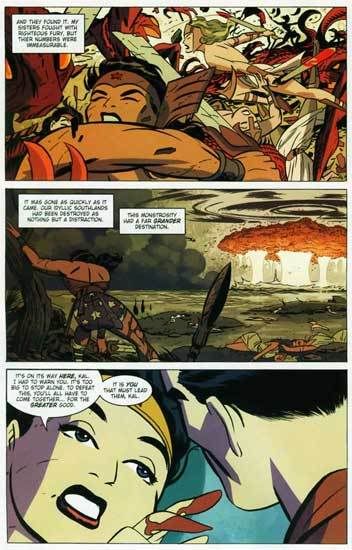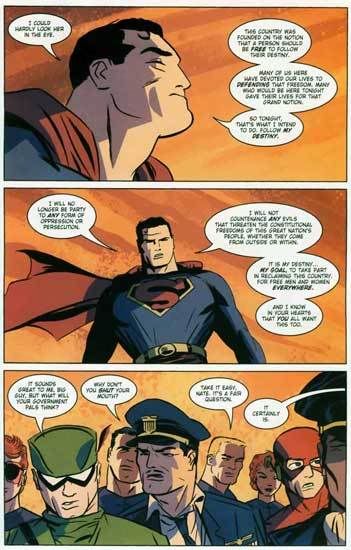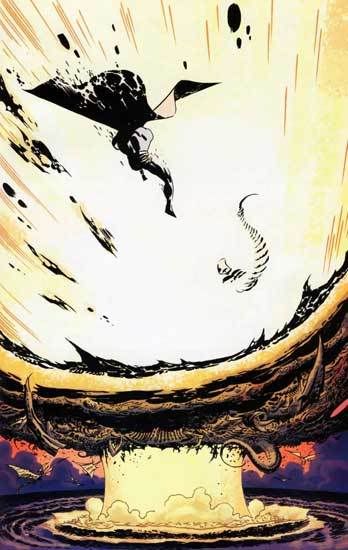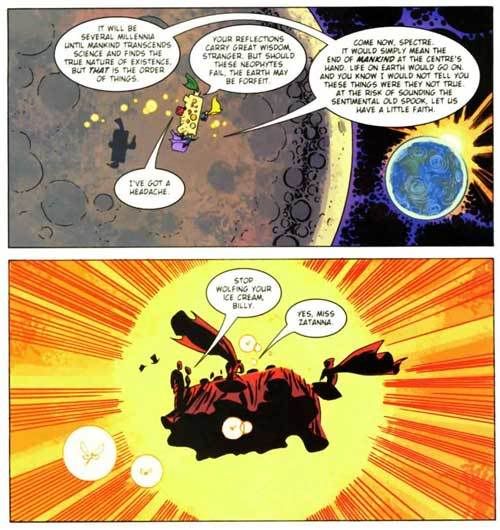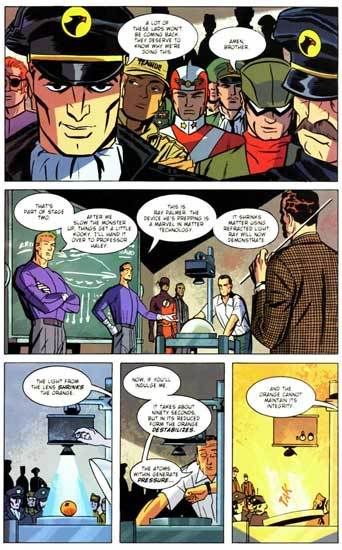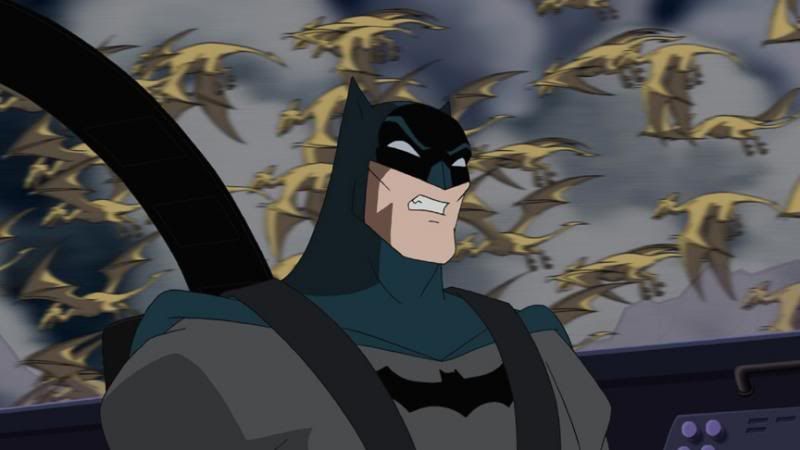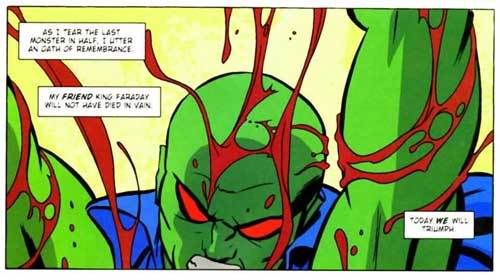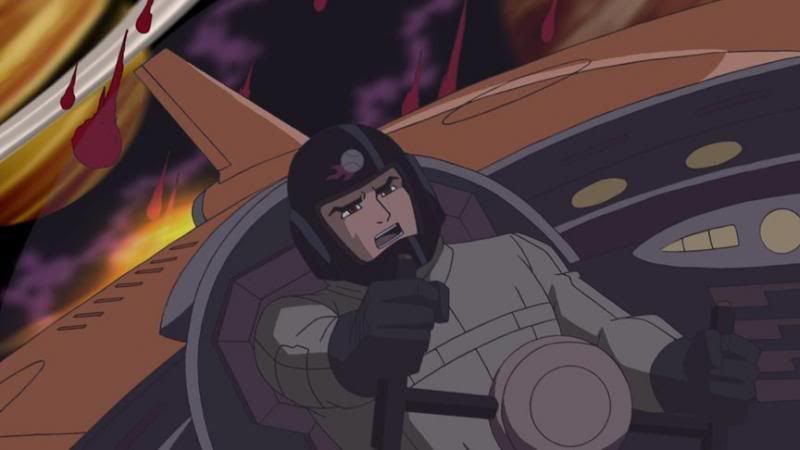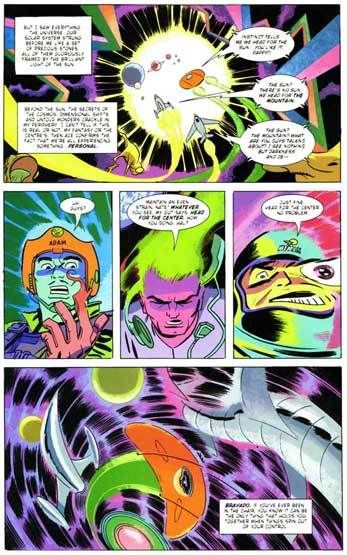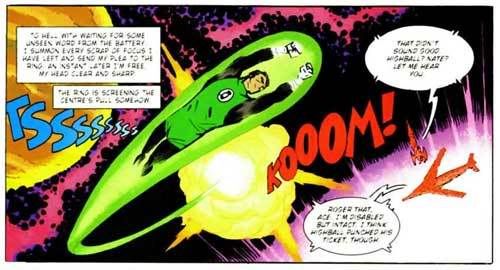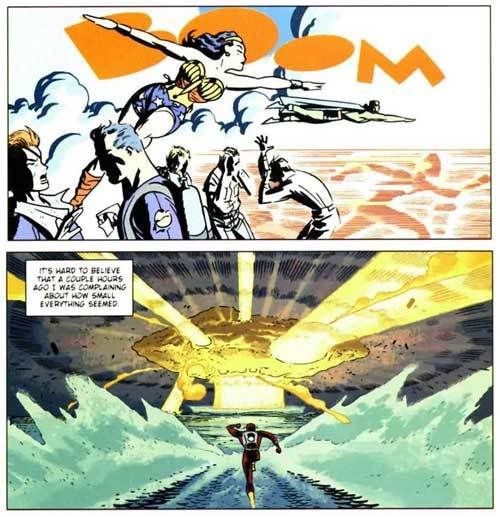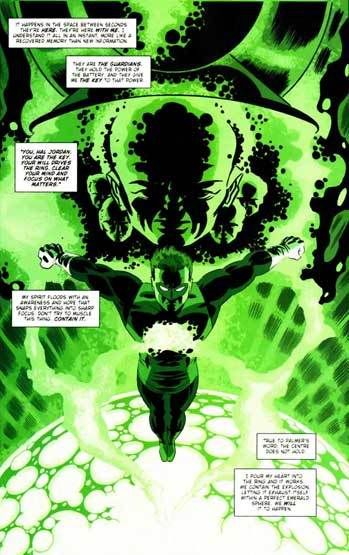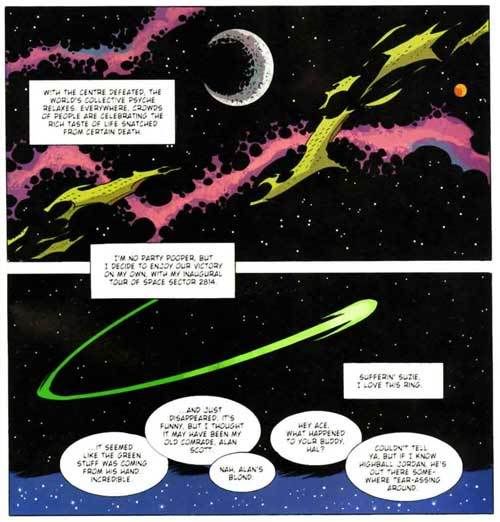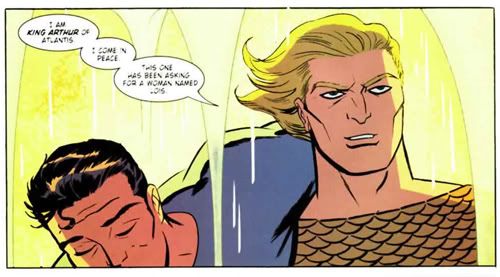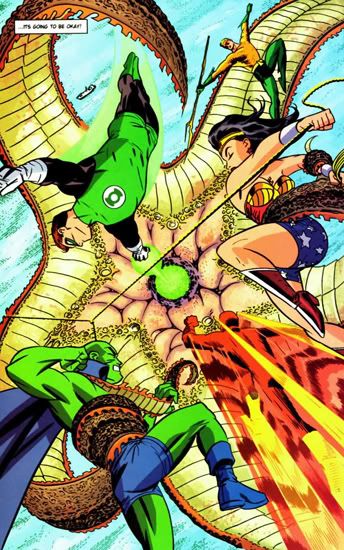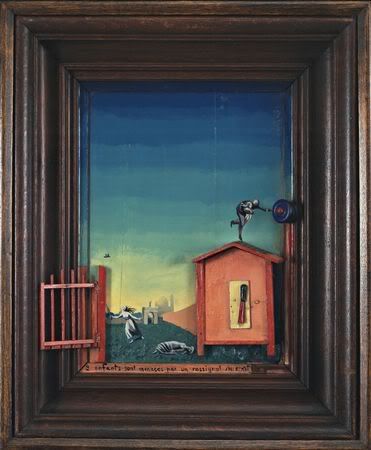
"2 enfants sont menacés par un rossignol/Two Children Are Threatened By A Nightingale", Max Ernst 1924
This one's for my sister Jade and my brother-in-law Jay, the biggest fans of Hayao Miyazaki and They Might Be Giants that I know, and who recently gifted me with "A Week of Kindness". The primary focus of this article is Miyazaki's masterful 2004 film "Howl's Moving Castle", which I've already talked about a little in Legerdemain of the Dark Knight I: The Pledge, and this article does directly relate to my observations in that series. As per the usual, I would have liked to have covered this subject in one article, it is after all just one movie, but that does not look to be possible. Both image and story of "Howl's Moving Castle" are thick like custard with items of occult interest. And for the fan of fantasy with an eye for the symbols, this movie is totally dessert, rich but irresistible.
But I start with Ernst because I really have no doubt that his masterpiece above is purposefully evoked by both the Miyazaki "Howl's Moving Castle" and the TMBG song this article takes its name from. You know this song, right? From 1990's "Flood"? If you haven't (and even if you have) you should check out the video.
The Giants broadly demonstrate that surrealism is pop culture. And you know I love a direct correlation made between illumination, the Language of the Birds, the color Blue and Jason and the Argonauts. Plus it's nice to be reminded that black and white Chuck Taylor All-Star's are the ideal foot wear for the modern-era esotericist, who are prone to gazing down at their shoes when they aren't looking up at the stars. At any rate, the pentacles ward your feet from danger.
According to the Museum of Modern Art, "Two Children Are Threatened By A Nightingale" was created the same year that the Surrealist movement was officially founded (via Breton's first manifesto). The haunting collage of illusionistic painting (evocative of the work of Giorgio de Chirico) and three dimensional found objects was likened by Ernst to childhood dreams and memories. His combination of "real" and "unreal" elements facilitates the viewer's movement into this universal Other World, the Dreamtime. On the surface there is something incongruous about feeling a sense of menace from a Nightingale, a song bird, diminutive and harmless to all but insects. But when we talk about the Language of the Birds we are at least in part evoking the ancient practice of augury. Birds are omens, ask the robins now that it is Spring, but the messages they carry are not always auspicious. The Nightingale is the Night Singer (whistling in the dark), specifically singing in the Twilight, a harbinger of night fall, and children are afraid of the dark. This is why maybe, in Twin Peaks Laura Palmer is likened to a nightingale in a kl,song sung by Julee Cruise.
It's my opinion that to fully appreciate Ernst's work we must keep in mind his service as a young man as a German soldier during World War I. Amongst the "innovations" of that war was the first use of aerial bombardment. In that sense it is easy to see why children might be terrified by something as tiny as a bird way up in the sky. Lookng at the painting again with this in mind it is not so strange a scene at all. Even the doorbell the man carrying the baby on the roof top runs to makes sense in this light. It is downright prescient, predicting button-press warfare. From our vantage point in history we can see that the twilight this nightingale sang from proceeded the longest, darkest night time of all, and still ongoing.
I have not and do not plan to read the novel "Howl's Moving Castle" by Diana Wynne Jones, so this article deals only with the movie, but my sister has and she holds the opinion that this is one of the rare cases when the adaptation exceeds the source material. And apparently some of my primary points of interest here are aspects added to the story by Miyazaki, the Blue Bird/Beast form of Howl and the entire storyline of the War. According to the Wikipedia article, in an interview with Newsweek, pacifist Miyazaki described how "Howl's" production began around the time of America's invasion of Iraq and his anger at this action "profoundly impacted" the film.
"Howl's Moving Castle" is clearly a fairy tale, a romance about curses and relationships, set in a steampunkish Other World, vaguely Victorian European, an industrial era but in a place where magic is real, an art practiced by Witches and Wizards. It is a place both familiar and alien, a dream reality, like so many Miyazaki locales. As stated in the Legerdemain article, I find synchronistic correlation through the performances of actor Christian Bale between the characters of the wizard Howl, the magician Twins Albert and Frederick Borden from "The Prestige" and the latest cinema version of the Batman ("Batman Begins" and "Howl's Moving Castle", by the way, were released to U.S. theaters within days of one another). Another prevalent detail of "Howl's" are the clear allusions to both Alice In Wonderland and the Wonderful Wizard of Oz. I used the English dubbed Disney released version of this movie in preparation of this article. Also invaluable, besides good old Wikipedia and YouTube, was the Hayao Miyazaki digital shrine Nausicaa.net.
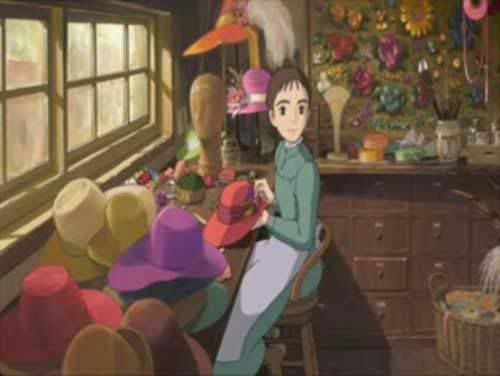
One interesting Alice synch happens early when we are first introduced to our protagonist, Sophie Hatter. She works in her parents' millinery shop decorating hats with silk flowers and other ornamentation. Sophie is a Hatter by name and by vocation, but the opposite of the Mad Hatter of Wonderland, female instead of male, young instead of old, and not at all Mad. And she is not just a Sane Hatter but a Wise Hatter (Sophia=Wisdom). But as we'll see being young and wise can itself be a kind of curse. It is interesting to see a character personifying Wisdom whose occupation is the ornamentation of Hats, symbolic representatives of the people wearing them, or the thoughts taking place underneath them. This is evident through idiom alone. To have a "bee in your bonnet" is to be obsessed with or excited by an overwhelming idea or opinion.
Sophie begins her story in what seems a secret garden, but we might note that as beautiful as they are, the flowers here are fakes (not unlike the false garden of trick flowers in Angier's workshop in "The Prestige"). Amongst the blossoms are roses, sunflowers, forget-me-nots and irises, as well as goddess indicating feathers from peacocks and possibly swans. If this small back room is a sanctuary, it is also a self-imposed exile. Maidenly Sophie has cloistered herself, ostensibly out of family duty but more so due to a view of herself as plain and insignificant. Illustrating this, in contrast to the elaborate headgear Sophie decorates, is the unassuming hat she chooses for herself, embellished simply with three berries, possibly cherries. This emblem, three equi-size circles, is of interest here with this character as indicator of a tripartite goddess (i.e. a goddess incarnate in three separate forms, often Maiden, Matron and Crone). Esotric symbolist Harold Bayley likely would equate the presentation of these three circles to the essential Zoroastrian principles of Good Thought, Good Word and Good Deed, qualities Sophie Hatter certainly embodies.
Sophie works late as the shop closes up. The other girls she works with see the mobile castle of the infamous Wizard Howl on the outskirts of town out the window, and tease one another over the rumors that he steals and eats the hearts of pretty girls. Sophie walks to meet her younger sister Lettie who works in the bakery of an upscale hotel. The town, Market Chipping, bustles with color and activity, and is conducting a military parade, an activity that comes across as common place. Sophie ducks into an alleyway to avoid the commotion, but she's stopped and harassed by a pair of uniformed soldiers. Luckily a fashionably dressed young man comes along and sends the soldiers off, magically taking control of their bodies like puppets and marching them away.
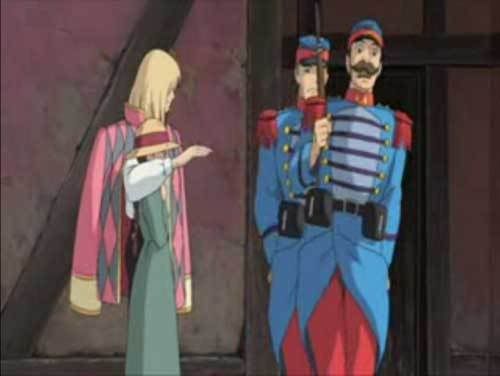
As this is obviously the first step of initiation for Sophie's path to her higher purpose, we can note the checkerboard pattern design of her initiator's jacket in this scene. We can note this same essential rescue/meeting occurring between Batman and Rachel Dawes in "Batman Begins", even more similarly between V and Evey in "V For Vendetta", and many other works of heroic romance. The young wizard insists on escorting Sophie to her destination, but he warns her that he is being followed, and this soon becomes apparent as figures ooze from the walls into the forms of shadowy blob-men wearing carnival masks and flat straw hats. They chase the pair down the alleyway, and they are cornered. To escape the wizard takes hold of Sophie and jumps straight up above the rooftops. He then walks with Sophie through the air above the town, effortlessly hopping from spire to spire.

And while the atmosphere and mood are certainly different, this moment is not so far removed from Batman and Rachel's rooftop drive in the Batmobile. He delivers her to a balcony of the hotel and bids her farewell before gracefully floating away.
Sophie's sister Lettie is bubbly and pretty, and obviously popular with male customers and coworkers. She's startled to hear about her sister's unusual entrance and rushes away to meet with her for a chat in the stockroom.
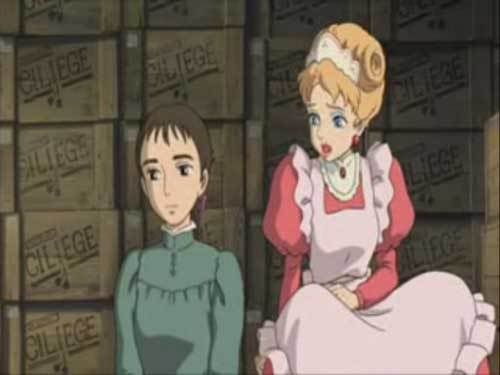
The sisters talk resting on crates of Cherries. This major signifier is highlighted at this point in the story, but in a quiet and unobtrusive manner. Bayley's thoughts on the hidden symbolism of the word "cherry", as described in his 1912 "The Lost Language of Symbolism, Volume II", proves to be of interest:
"- a word [cherries] that is identical with cheres (Mencheres was an Egyptian royal name), meaning in Hebrew orb of the Sun, and with charis, the Greek for grace, cognate with our charity or love. Cheery means happy or light-hearted; ma chérie is the French for my darling; a caress is an ac Eros or great love; and to cherish is to protect lovingly. According to Persian theology, the Ized entrusted with the care of the Sun disk was named Chur; there is a Cherhill or Hill of Cher at Avebury; and Cher, the "Ever-Existent Fire," enters into innumerable place-names from Cherhill, Cherbury, and Cherbourg, to Pondicherry. The naga or sacred cobra (Ac ob ur A, Great Eye Fire of Primal Cause) is in some parts of India known as the chera, and its worshipers term themselves in various localities the Cherus, Cheras, Seras, Kiras, or Keralas.
The English cherries varies into the French cerises, German kirsches, Greek kerasos (it has been surmised that cherries first came from the Black Sea town named Cerasus, now called Kheresoun), and the same root is responsible for cherub and kerub. The Hebrew Ark was surmounted by protective kerubim; ker or car is Celtic for a fortress; and kirk is Scotch for church.
Cherries, the ruddy little orbs of the Sun, are one of the myriad fruits of Ceres, the Goddess of growth and giver of increase. The name Ceres-whence, no doubt, crescere, to grow, and thence increase-is resolvable either into ac Eros, ac Horus, or across, the "Great Firelight." The Greek name for Ceres or Isis was Demeter, i.e. the Resplendent Mother, and she was represented as holding a wheat-ear or a poppy."
Which is a lot to take in and digest in a shot, I know, and controversial to say the least, but fascinating none the less. Sophie returns to the shop, where she also lives. Despite being closed, a monolithic woman, looking much like a large crow, enters the shop and makes disparaging comments about it and Sophie.
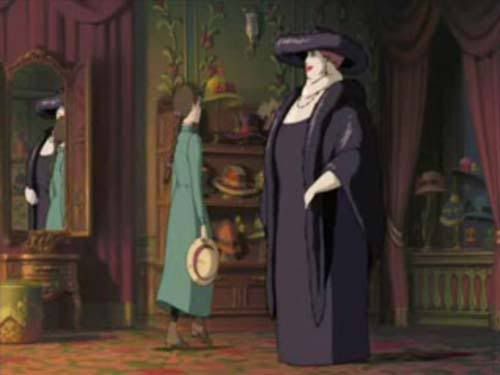
Sophie shows her the door and sees the woman is accompanied by the shadow-blob men.
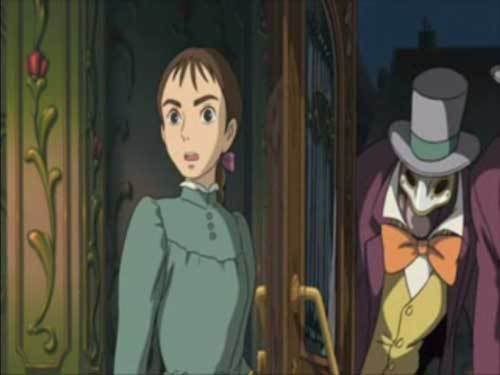
She identifies herself as the Witch of the Waste (an open, punning reference to the Witch of the West). As the rude woman leaves she transmutes into smoke or black wind and passes straight through Sophie, cursing her. The Witch tells Sophie that she can't tell anyone about the curse and asks her to give her regards to Howl. Quickly Sophie discovers the spell's effect. She's been transformed from a maiden into a crone, the evidence supplied by a tripartite looking glass.
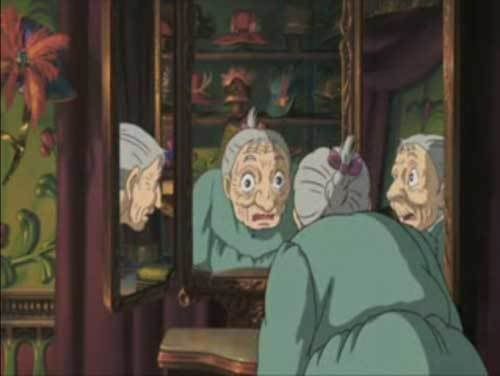
We can clearly see the floral/rose detailing throughout the hat shop. Sophie wakes to discover her transformation was real. That same morning her mother returns from a trip to the city, showing off a ridiculously over-styled hat she purchased there.

The hat's details, quite interestingly, are a rebus equaling Swan Knight, and this fleeting piece of costuming may very well be Miyazaki's indication of the type of story he is telling. Sophie's mother visually and otherwise holds more in common with Lettie then unassuming Sophie. Unable to describe what's been done to her due to the restriction of the curse, Sophie feigns illness, and later slips out unseen, first stopping by the kitchen to gather provisions for a journey.
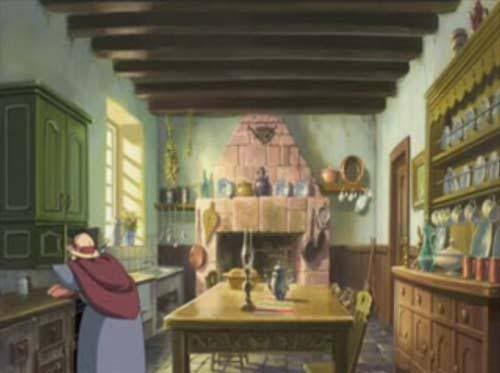
Note the truncated pyramid serving as the chimney. This is a film where the format of fireplaces holds importance. Sophie is actually relatively composed regarding her transformation, musing that at least now her clothes suit her, though she is already frustrated by the aches and pains of old age and the physical limitations. She heads out of town toward the area called the Wastes (think Grail-legend Waste Lands) where only Witches and Wizards dwell in search of a way to reverse her curse, hitching a ride part way on the back of a haywain.
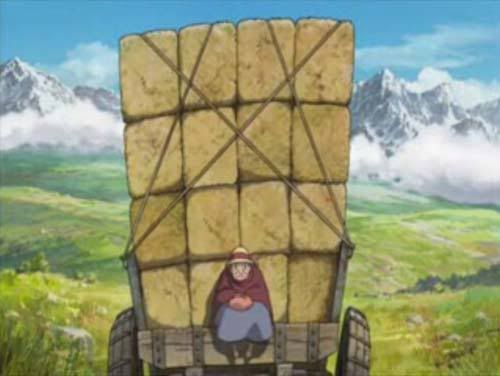
As Sophie's initiation continues we should in no way be surprised to find her here before a grid-pattern, and one apparently tied together with male and female triangles meeting, visually the four bottom points of a pentagram. Also, as we should expect, Sophie's trek is an upward climb. Transportation by Grain is a goddess indicating concept, and visually indicates an agricultural origin at the onset of Sophie's journey. We can see how this same pattern is presented as a story rather than as a visual element with farm girl Dorothy Gale.
The haywain only carries her a short way, as only Witches and Wizards, nobody sensible, travels into the Wastes. Going on by foot Sophie quickly grows tired and feels that despite walking through the day she's barely made any distance. She spots a sturdy looking branch sticking up from some brush and thinks it might make a good cane. But when she goes to pull it out she discovers it is a Scarecrow that had fallen over. Set upright it magically stands on its own.
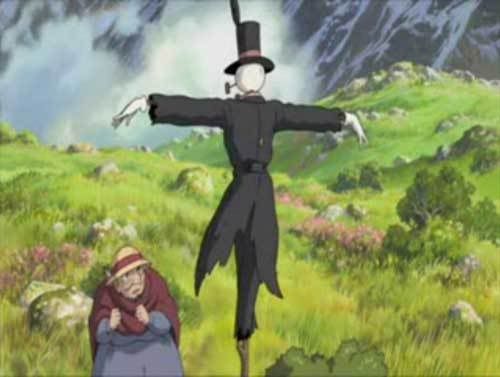
Like Dorothy, the first companion Sophie Hatter encounters is an animate Scarecrow, whom she names Turnip Head, because his head is a turnip, and because it's the kind of thing you might call someone who doesn't have any brains. This apparent lack of brains is emphasized by Turnip Head's tall but open top hat. But we might note that both Turnip Head and the Scarecrow of Oz turn out to be more open-minded then empty headed. Amazingly "Batman Begins" also features a Scarecrow in a supporting role. In every case the Scarecrow, Straw Man, Effigy Figure represents Dionysus or a related Solar/Agricultural Resurrection figure. Turnip Head is even presented throughout the film in cruciform.
Sophie continues on her way up the hill, but discovers Turnip Head is hopping along behind her. He turns out to be a very helpful sort as he has found her a cane to make her walking easier.
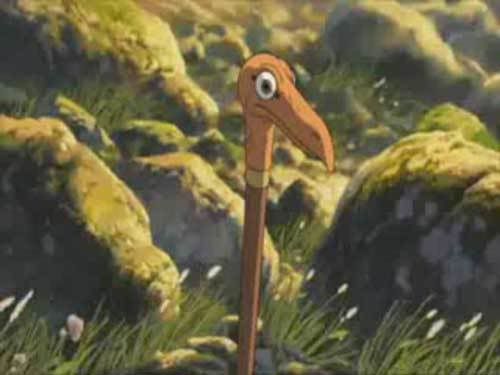
A finely carved walking stick dedicated not just to birds but to a Thoth indicative wisdom symbol Crane. A Crane Cane (and the secret identity of the Batman villain Scarecrow is Jonathan Crane). As lovely a prop as this is, it is yet another subtle symbolic detail. The cane is not magical, it is just a very good walking stick, a facilitator for her journey. Sophie is thankful, but a bit leery of the magical Turnip Head who is obviously under some curse of his own. Seeing his desire to serve she asks him to find her someplace to take shelter, thinking she can ditch him while he searches. She continues on, but she is tired and cold and night is falling. She smells smoke and thinks she might find a cottage nearby where she could stay the night. She soon finds however that the smoke she smells is coming from Howl's Moving Castle, ambling at her with Turnip Head hopping before it as if leading the way.
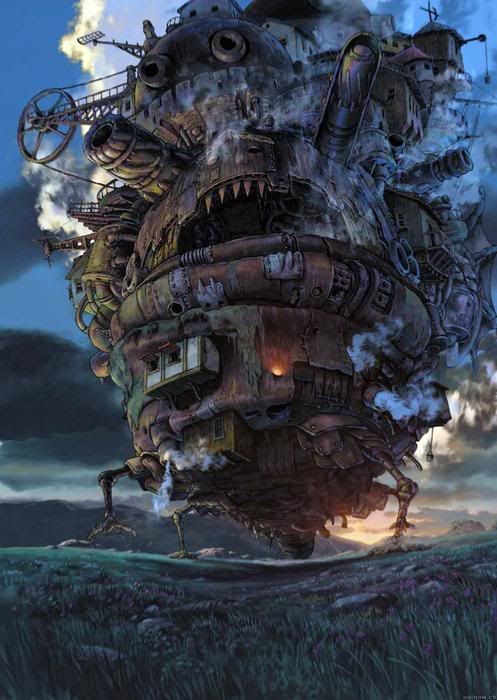
A chaotic, apparently steam-powered, found-object collage of architecture and machine-parts, animal-like too, moving about on bird legs like Baba Yaga's Hut. Sophie is startled, but needs shelter so she runs and takes a leap for the door. As the title object and predominant image of this story the symbolism of the Moving Castle takes central importance. The Castle is a specification of the general symbolism of the House. As a dream symbol, Biedermann notes the Jungian interpretation that the House represents the individual who dwells there, and the state of the house (i.e. orderly, dilapidated, remodeled) reflects their inner nature. Cirlot points out that the House is traditionally feminine in nature, and as the repository of wisdom, representative of Tradition itself, which is easy enough to confirm through common usage. On top of this is the specific symbolism of the Castle, which Cirlot describes "in the broadest sense" as "embattled, spiritual power, ever on the watch". He calls the "black castle" the "alchemists' lair", "the Mansion of the Beyond" and "entrance to the Other World". Citing symbolist Count Pierre V. Piobb, "-the sudden appearance of a castle in the path of a wanderer is like the sudden awareness of a spiritual pattern".
Cirlot also likens the castle to the domain of Pluto, the Underworld. This is an interesting point as the story of Howl's Moving Castle very much follows the pattern of the Persephone legend. On the surface this might suggest sinister overtones, but this is such an essential model for fairy tales and romances that it is not really uncommon to find cases like this of sympathy for the devil. At its heart it is Beauty and the Beast. The Wizard Howl is considered to be a monster, described in almost vampiric terms as the eater of young girls' hearts, and of course there is a romantic thrill of this to his potential victims. This is an image Howl cultivates as a means to keep people at a distance.
But if the state of a house reflects the inner character of its dweller, this does not say great things about Howl as Sophie discovers the inside as chaotic as the outside, cluttered, dirty and all around unkempt. Prominent display is made of Spiders in their Webs. Still, any port in a storm, Sophie sits down by the fire and starts to fall asleep. Then the fire speaks to her, revealing itself as sentient, a Fire Demon named Calcifer.
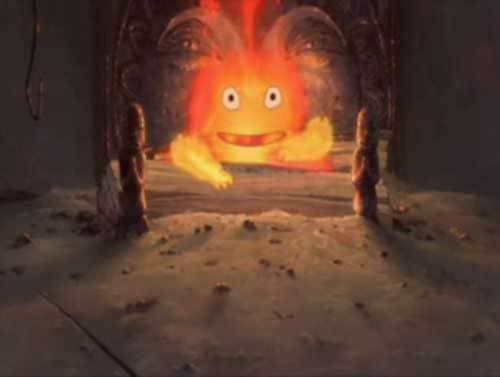
Note the idol face and prayer-positioned figures of Calcifer's shrine-like hearth. Calcifer recognizes the curse on Sophie instantly and she asks if he would be able to lift it from her. He suggests that he could, but she would have to do something for him first, namely get him out of his service contract with Howl (the details of which he is likewise forbidden to discuss). Sophie is uncertain, it seems unwise to make a deal with a demon, but she accepts after he bemoans his station, describing himself as Howl's slave. Sophie agrees to the bargain and instantly nods off.
Morning comes and with it Sophie's first day as a resident of Howl's Moving Castle, an Other World within the Other World. In the city of Porthaven a number of battleships head out for war amidst much fanfare.

The Mayor of the city approaches and knocks upon the door of the humble looking shop of the Great Wizard Jenkins. Somehow this is the door of Howl's castle and a young boy, Markl, rushes downstairs to answer it, wondering at the old lady asleep before the fire on his way by. Before answering he magically disguises himself as a (very) little old man with long beard.
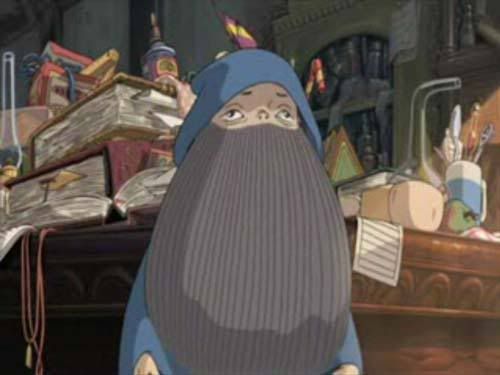
The Mayor has come with an invitation to the Wizard Jenkins to meet with the King. War has been declared by a neighboring kingdom, and all the Witches and Wizards are being drafted into military service.
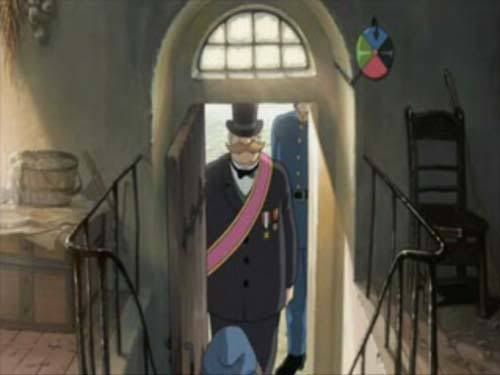
Markl informs the Mayor that his master is not in but that he will pass on his message. When the Mayor has left the boy removes his disguise and questions Sophie, now awake and tending to the fire. This is interrupted by another ring at the door (the Porthaven Door) and Markl throws his disguise back on to sell a potion ensuring safe boating to a little girl on behalf of her mother. As this takes place Sophie realizes the door and the window open out to the sea side city of Porthaven, far removed from Market Chipping and the Wastes where she entered. A third visitor comes and this time Calcifer announces that it is the Kingsbury door. A four colored wheel by the door turns as Markl answers, and the door this time opens to the royal city of Kingsbury rather then Porthaven.

It is a royal emissary, this time looking for the Wizard Pendragon (a blatantly Arthurian detail), again to enlist him for service in the war. Again Markl promises to pass along the message. Sophie realizes that the door is magical, able to open to four different locations indicated by the colors on the wheel, the simple X or cross in a circle, a solar glyph and the image of cyclical time, indicative of the Age Shift concept underlying many magical portals. Once Markl is away from the door Sophie experiments, discovering Blue leads to Porthaven, Red to Kingsbury and Green to the Wastes above Market Chipping. Markl stops her before she can open the Black door, only Howl knows where it goes.
Through this scene we see how Howl is a maintainer of multiple secret identities, operating under different names in different places. Like Batman (though this is not a feature of the current film series) he is assisted in his operations by a young ward or apprentice who shares his Other World symbolizing headquarters and likewise maintains a false identity. Markl goes to have a meal of bread and cheese, but Sophie, seeing eggs and bacon, asks if he would rather have a hot breakfast. Markl says they can't because Calcifer will only cook food for Howl. Sophie, however, cajoles the fire demon into working for her on the threat of telling Howl about their bargain. Markl is amazed that Calcifer does what Sophie tells him to do. As she cooks the wheel turns to black and Howl stumbles in as if exhausted.
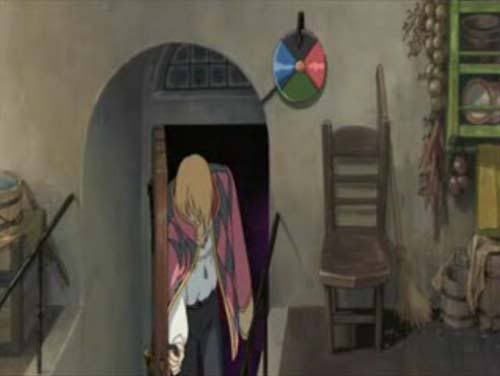
Howl does not seem overtly surprised by Sophie's presence. She passes herself off as the new cleaning lady hired by Calcifer. Howl welcomes her into the fold by taking over cooking duties and serving everyone breakfast. As they eat he detects a letter in Sophie's pocket but as she passes it over it bursts into flame and burns a magical mark onto the table. It is a message from the Witch of the Waste that he reads as saying that as he caught a falling star, so shall she possess the heart of him, the heartless man. Of course we are all familiar with an Oz figure lacking a heart. Howl erases the message and leaves to take a bath. Markl wonders if Sophie works for the Witch of the Waste. Her curse prevents her from describing her circumstance, but Sophie still manages to express her enmity towards the Witch.
Sophie then begins her house cleaning duties, during which she almost lets Calcifer's fire go out. Howl breathes life back into the fire demon and departs into an infernal location through the black door. Calcifer informs Sophie that if he dies then Howl will also die. During the cleanup Sophie also comes to realize that it is Calcifer's magic that animates the Castle, a fact that gives her new respect for the demon. Out on the balcony she finds Turnip Head caught in the mechanisms of the Castle and sets him free again. He then helps her and Markl with the house keeping duties. Meanwhile Howl, in a partially blue-feathered, swallow-tailed bird form, flies above a city undergoing aerial bombardment. He's attacked and has a fierce battle with hat wearing tadpole men with insect wings.
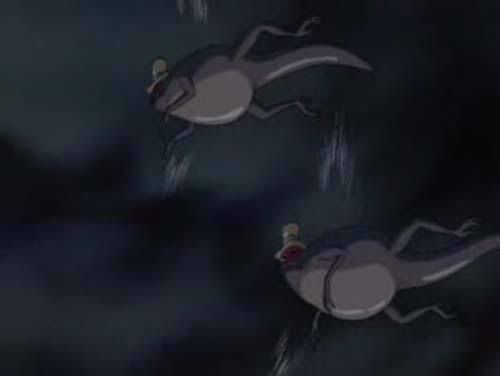
Seen here from a scene later in the film. These forms are more than reminiscent of damned Rebel Angels falling above Eden as depicted in the left panel of Bosch's Haywain triptych. Likewise the images of the city burning under the blitz appear much like the burning buildings present in many of Bosch's depictions of Hell.
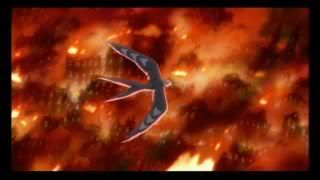
Returning exhausted to the Castle, Calcifer warns Howl that if he isn't careful he'll one day become stuck in the monstrous bird-form. Howl confirms that the creatures he fought were themselves Wizards trapped in inhuman form by the misuse of their magic (like Fallen Angels). As he goes to take his bath Howl looks upon the sleeping Sophie, and we see with him that when she's asleep she returns to her normal, youthful state. She's startled awake by the sound of the running water and is instantly old again.
The next morning Sophie and Markl (in disguise) go into Porthaven to do some shopping, and witness the return of one of the massive battleships, heavily damaged from warfare. Sophie spies one of the Witch's blob men, and they rush back to the Castle as an enemy plane drops propaganda leaflets on the town. At the castle they hear a scream from the bathroom, and Howl runs out distraught as his blond hair is now a bright orange.
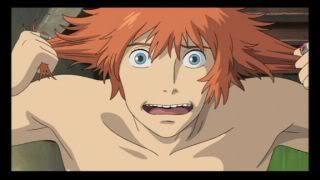
Sophie's cleaning confused him and he dyed his hair the wrong color, a devastating event for the highly vain Howl. This is a good moment to point out the highly feminine characteristics of the male romantic lead of this story. Pretty, graceful and fashion conscious, he is still a ladies man, making him a symbolic hermaphrodite, an important characteristic for an alchemist figure. We can note the phase shift or transmutation implied from a change in hair color. Howl's physical state seems to mirror the weather of his emotions. He drops into a listless sulk, stating "I don't want to live if I can't be beautiful", his hair shifts to purple then bluish-black (apparently his natural shade). Oppressive, animate shadows fill the room, oozing through the cracks and his body begins emitting a green ooze. Sophie, upset at being blamed, and by Howl's childish self-concern, runs out into the rain falling on the Wastes. Turnip Head hops in carrying an umbrella for her. Sophie does not seem to notice, but she becomes a little bit younger while she's crying over Howl.
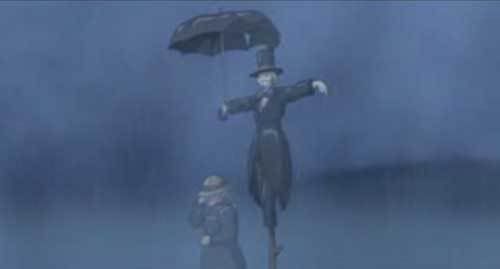
Markl comes out to retrieve Sophie. The depressed Howl is oozing dangerously close to Calcifer, and if Calcifer is extinguished both of them will die.
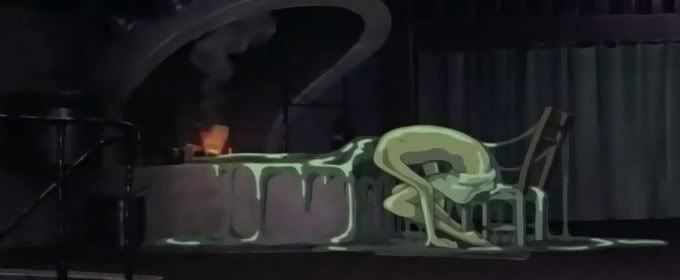
Sophie and Markl carry Howl to the bathroom to get him cleaned up and she sets to mopping up the slime. Later he recuperates in his bedroom and Sophie checks in to see how he is doing.
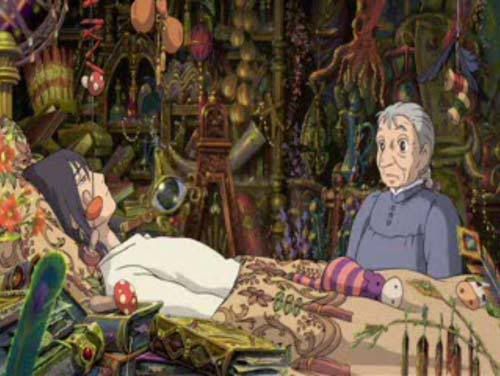
Occult significant symbols are presented here in a jumble too thick for full deciphering, but include an All-Seeing Eye set on a metronome, more peacock feathers, mandrake root, an Octopus, and a string of fly agaric mushrooms (right beside the pillow where he dreams). Even the stuffed animal on his bed (demonstrating Howl's childish nature) seems an indicator to Disney's version of the Cheshire Cat. Howl reveals that he is really upset with himself. He knows the Witch is seeking him out, but he is too much of a coward to face her. It is likewise cowardice that prevents him from reporting to the King as ordered, despite the fact that he took an oath to follow the King's commands as part of his training as a Wizard. The document is pinned to a dart board.
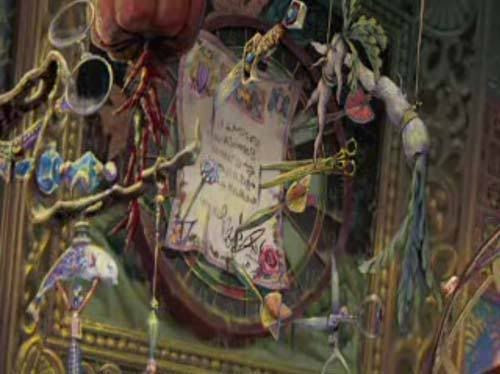
Naturally this diploma from a Mystery School is marked with the sign of a Rose. When asked by Sophie about his aliases Howl states he uses them to maintain his freedom, which seems quite in line with the reasoning of the Borden twins in "The Prestige". Like Miyazaki, Howl is a pacifist, and Sophie suggests he report to the King to deliver his refusal to participate in the senseless warfare.
Howl gets another idea to deal with the situation, asking Sophie to pose as the Wizard Pendragon's mother and report to the King's chief sorceress Madame Suliman to apologize for his cowardice. Sophie is uncertain, but Howl assures her he will be nearby in disguised form and he gives her a Ring he states will bring her back to the castle. As Sophie makes her way to the palace in Kingsbury she wonders what form Howl has chosen as a disguise, dismissing the idea that he would be a crow or a pigeon. When an elderly mutt with a barely audible wheeze for a bark starts to follow close behind her she assumes he must be Howl.
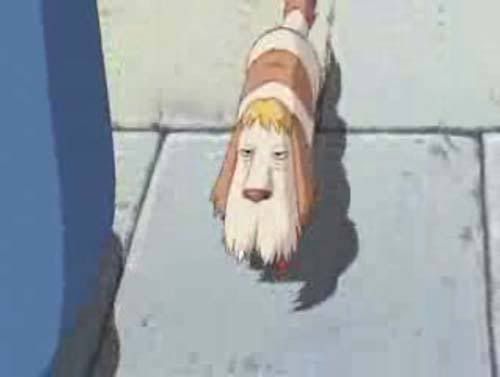
She has little chance to think this over before her attention is grabbed by the approach of the Witch of the Waste carried in her litter by her blob-man servants, which is apparently bigger on then inside then it appears on the outside.

The Witch gloats at her invitation to serve the King, as her power is in great demand. Sophie asks if she is so great then why doesn't she prove it by removing her curse. The Witch replies her talent lies in casting spells, not breaking them. But when her litter passes through the palace gates a protective ward dissolves the blob-men, their animating spirits drawn out into simple figure drawings on the ground. The Witch is forced to climb the massive steps leading to the palace like anyone else, an action she insists Suliman is cruelly inflicting to humble her. It becomes a kind of race up the steps between elderly Sophie, carrying the dog, and the obese Witch, but it soon becomes apparent that it is no contest at all. While Sophie's progress is slow the Witch strains to make it up each step. She sweats profusely and her form shifts fluidly, as the effort seems to drain her vitality. She grows uglier with every step. Sophie asks why she doesn't just give up and the Witch replies she's been waiting fifty years for an invitation, since Suliman banished her to live in the Wastes.
Sophie is so pure of heart that after she reaches the top she turns to cheer her enemy on. Inside the Witch collapses in exhaustion in a chair set in the center of the room. Sophie is led by a page into a conservatory to meet with Madame Suliman. After Sophie has left curtains around the room are drawn revealing giant incandescent bulbs.
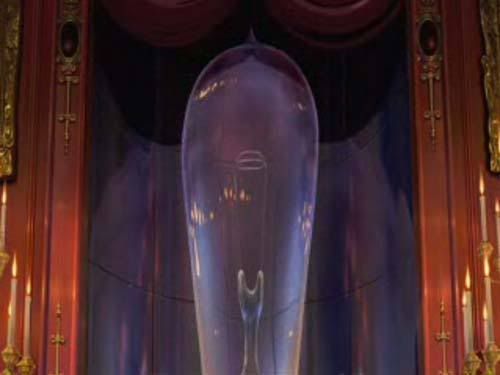
A hand throws a switch lighting them, and the Witch is bathed in light. A ring of twelve shadowy beings appear and slowly dance around her. Twelve in a circle is the cycle of Time, especially zodiacal in this image with Dragon decorated carpet, the Dragon representing the major constellation Draco as well as the serpentine path of the ecliptic of the Sun.
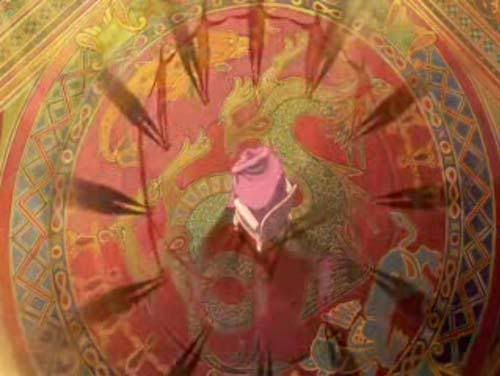
Meanwhile, Sophie is led to Suliman's conservatory, an indoor Eden complete with Cycads and an over-flowing Grail.
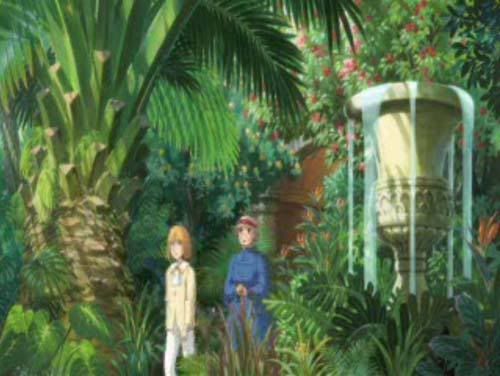
Madame Suliman greets Sophie as Mrs. Pendragon, Howl's mother. Sophie sees the dog, Heen, beside the sorceress, and is surprised to learn that he is Suliman's errand dog, whom she sent to escort Sophie to the palace.
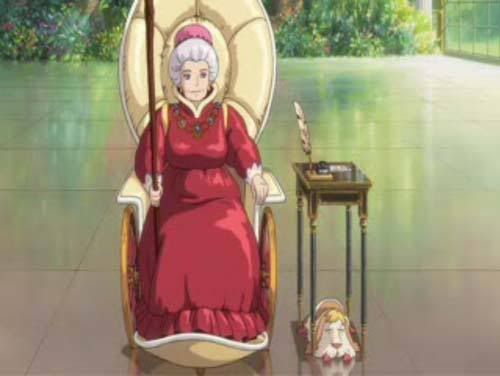
Notice that Suliman, a wheel-chair bound Occult instructor, the master initiator, is kept framed in a mandalora by her chair. Sophie offers her apologies for Howl and Suliman acts disappointed, identifying Howl as the last of her apprentices, and the most talented she had encountered, talent she hoped would one day allow him to take her place as the royal wizard. But, she continues, once his heart was stolen by a demon he never returned for further learning, and began using his powers for purely selfish reasons. She then warns Sophie that Howl's powers are far too dangerous for someone without a heart. She has the Witch of the Waste wheeled in, now a shriveled old dwarf, completely vacuous and stripped of all her powers.
Suliman returned the Witch to her proper age, and explains that the Witch too once held great promise, until she made a bargain to a Demon of Greed and lost her way. Suliman states the Kingdom will no longer tolerate reckless Witches and Wizards and offers an ultimatum for Howl. He can return to her service and have his demon removed or have his powers taken away. Sophie is outraged by this, the trap Suliman laid and her bullying use of her power. As she defends Howl to Suliman she grows younger with every word. Suliman now understands that Sophie is in love with Howl (we can assume she was never fooled by the lie about being his mother), and Suliman believes she now knows Howl's weakness.
Outside a small flying craft lands and a man Suliman identifies as the King enters the conservatory. The King states he has decided not to use magic to try to win the war, as the shields protecting the palace merely cause the bombs to fall elsewhere and hurt civilians. But then a second King enters, and his manner is far less refined, as he boasts of new plans to beat the enemy to a pulp.
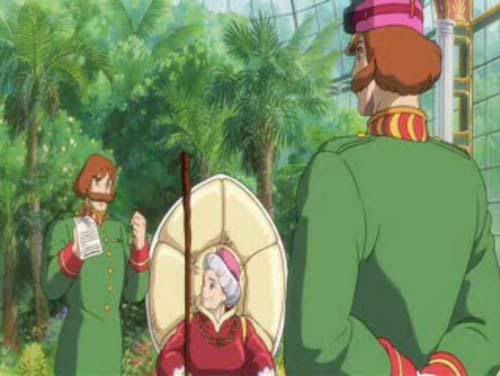
The King assumes his double is a creation by Suliman for his protection. As he leaves she scolds Howl for his weak disguise. Howl counters he's reported as ordered but he and his "mother" are now leaving. Suliman disagrees. She taps her staff on the floor and opens a circular portal twinkling with stars. Then a torrent of water floods out and washes over Howl and Sophie. A moment later they, and the shriveled up Witch of the Waste, are floating in the sky high above the ground. Shooting stars rain down, exploding about them like fireworks.
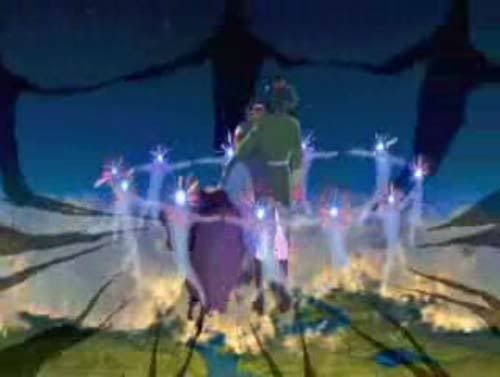
The stars become the radiant heads of light-bodied entities who ring around the trio just like the shadows that stole the Witch's magic. Howl starts to transform into his demonic Bird form, just bestial enough to remind us that this process is inherently Dionysian in nature.
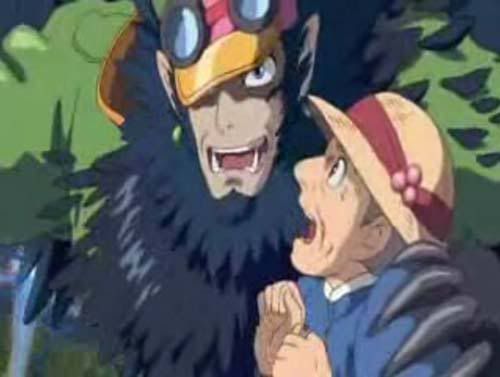
Suliman appears, standing, and her staff becomes a shaft of light she tries to run through Howl, but he flies up and away, and the staff only hits Sophie's dropped hat. They break through the glass ceiling of the conservatory (their experience inside an illusion), and Howl becomes human once more. Still with them is the pathetic, feeble Witch of the Waste, clutching desperately to Sophie's skirt. Howl lands them by the machine he flew in on and they quickly flutter away. Surprisingly, the dog Heen flies after using his ears like Dumbo, landing between Sophie and the Witch. As he's Suliman's dog Sophie can't trust him, but she can't just toss him over at this height either. Howl commands Sophie to take the wheel as the Kings airmen pursue. Howl says he'll distract them while Sophie flies back to the castle, informing her that the ring will lead the way if she summons Calcifer into her heart.
Sophie is mad that Howl has put her in this position if he was going to show up himself anyway, but he tells her that knowing that she would be there gave him the courage to face Suliman, and that Sophie saved him. He tells Sophie he can give her five minutes of invisibility, and then separates from them on a duplicate aircraft that darts off in another direction. At the Palace Suliman already concocts a plan to capture Howl using Sophie. In both Kingsbury and Porthaven the King's soldiers smash down the doors of the Wizards Jenkins and Pendragon, but find only empty, unused spaces. Sophie follows the light to Calcifer, flying through a downpour, returning herself and the stowaways to Howl's Castle in the Wastes. The ever important Magic Ring (the circle of Time) is here made one with the Torch of Enlightenment.
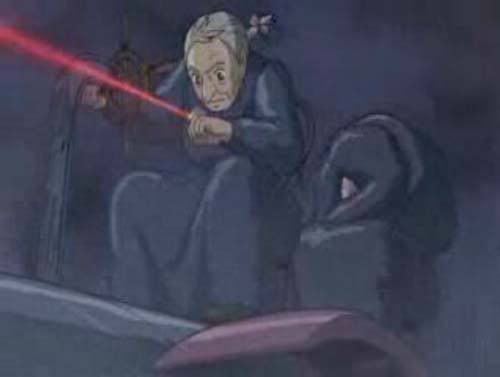
To be concluded...
